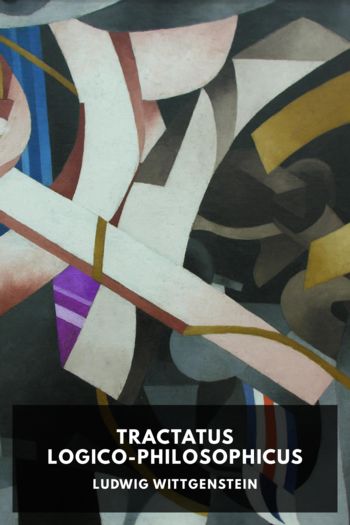Tractatus Logico-Philosophicus - Ludwig Wittgenstein (top 10 ebook reader TXT) 📗

- Author: Ludwig Wittgenstein
Book online «Tractatus Logico-Philosophicus - Ludwig Wittgenstein (top 10 ebook reader TXT) 📗». Author Ludwig Wittgenstein
In a certain sense we cannot make mistakes in logic.
5.4731Self-evidence, of which Russell has said so much, can only be discard in logic by language itself preventing every logical mistake. That logic is a priori consists in the fact that we cannot think illogically.
5.4732We cannot give a sign the wrong sense.
5.47321Occam’s razor is, of course, not an arbitrary rule nor one justified by its practical success. It simply says that unnecessary elements in a symbolism mean nothing.
Signs which serve one purpose are logically equivalent, signs which serve no purpose are logically meaningless.
5.4733Frege says: Every legitimately constructed proposition must have a sense; and I say: Every possible proposition is legitimately constructed, and if it has no sense this can only be because we have given no meaning to some of its constituent parts.
(Even if we believe that we have done so.)
Thus “Socrates is identical” says nothing, because we have given no meaning to the word “identical” as adjective. For when it occurs as the sign of equality it symbolizes in an entirely different way—the symbolizing relation is another—therefore the symbol is in the two cases entirely different; the two symbols have the sign in common with one another only by accident.
5.474The number of necessary fundamental operations depends only on our notation.
5.475It is only a question of constructing a system of signs of a definite number of dimensions—of a definite mathematical multiplicity.
5.476It is clear that we are not concerned here with a number of primitive ideas which must be signified but with the expression of a rule.
5.5Every truth-function is a result of the successive application of the operation (−−−−−T)(ξ,.....) to elementary propositions.
This operation denies all the propositions in the right-hand bracket and I call it the negation of these propositions.
5.501An expression in brackets whose terms are propositions I indicate—if the order of the terms in the bracket is indifferent—by a sign of the form “(ξ‾)”. “ξ” is a variable whose values are the terms of the expression in brackets, and the line over the variable indicates that it stands for all its values in the bracket.
(Thus if ξ has the 3 values P, Q, R, then (ξ‾)=(PQR).)
The values of the variables must be determined.
The determination is the description of the propositions which the variable stands for.
How the description of the terms of the expression in brackets takes place is unessential.
We may distinguish 3 kinds of description: 1. Direct enumeration. In this case we can place simply its constant values instead of the variable. 2. Giving a function fx, whose values for all values of x are the propositions to be described. 3. Giving a formal law, according to which those propositions are constructed. In this case the terms of the expression in brackets are all the terms of a formal series.
5.502Therefore I write instead of “(−−−−−T)(ξ,.....)”, “N(ξ‾)”.
N(ξ‾) is the negation of all the values of the propositional variable ξ.
5.503As it is obviously easy to express how propositions can be constructed by means of this operation and how propositions are not to be constructed by means of it, this must be capable of exact expression.
5.51If ξ has only one value, then N(ξ‾)=~p (not p), if it has two values then N(ξ‾)=~p.~q (neither p nor q).
5.511How can the all-embracing logic which mirrors the world use such special catches and manipulations? Only because all these are connected into an infinitely fine network, to the great mirror.
5.512“~p” is true if “p” is false. Therefore in the true proposition “~p” “p” is a false proposition. How then can the stroke “~” bring it into agreement with reality?
That which denies in “~p” is however not “~”, but that which all signs of this notation, which deny p, have in common.
Hence the common rule according to which “~p”, “~~~p”, “~p∨~p”, “~p.~p”, etc. etc. (to infinity) are constructed. And this which is common to them all mirrors denial.
5.513We could say: What is common to all symbols, which assert both p and q, is the proposition “p.q”. What is common to all symbols, which asserts either p or q, is the proposition “p∨q”.
And similarly we can say: Two propositions are opposed to one another when they have nothing in common with one another; and every proposition has only one negative, because there is only one proposition which lies altogether outside it.
Thus in Russell’s notation also it appears evident that “q:p∨~p” says the same thing as “q”; that “p∨~p” says nothing.
5.514If a notation is fixed, there is in it a rule according to which all the propositions denying p are constructed, a rule according to which all the propositions asserting p are constructed, a rule according to which all the propositions asserting p or q are constructed, and so on. These rules are equivalent to the symbols and in them their sense is mirrored.
5.515It must be recognized in our symbols that what is connected by “∨”, “.”, etc.,





Comments (0)